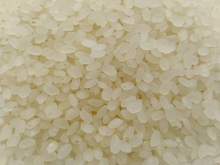Aromatic rice
Aromatic rice is one of the major types of rice.[1] It is a medium- to long-grained rice. It is known for its nut-like aroma and taste, which is caused by the chemical compound 2-acetyl-1-pyrroline.[2] Varieties of aromatic rice include Ambemohar, Basmati, Jasmine, Sona Masuri, Texmati, Tulaipanji, Tulshimala, Wehani, Gobindobhog and wild Pecan rice.[3] When cooked, the grains have a light and fluffy texture except for Gobindobhog rice which is sticky in texture.

Aromatic japonica (short-grain) rice
References
- "The U.S. Rice Export Market" (PDF). USDA. Nov 2000.
"There are four types of rice traded globally: indica, japonica, aromatic, and glutinous." - Ghareyazie, Behzad; Alinia, Faramarz; Menguito, Corazon A.; Rubia, Leila G.; De Palma, Justina M.; Liwanag, Evelyn A.; Cohen, Michael B.; Khush, Gurdev S.; Bennett, John (1997). "Enhanced resistance to two stem borers in an aromatic rice containing a synthetic cryIA(b) gene". Molecular Breeding. 3 (5): 401–414. doi:10.1023/A:1009695324100.
- Aromatic Rices. Int. Rice Res. Inst. 2000. pp. 8–. ISBN 978-81-204-1420-4.
Further reading
- R.K. Singh, U.S. Singh and G.S. Khush (editors). (2000). Aromatic rices. New Delhi : Oxford & IBH Pub. Google Books.
This article is issued from Wikipedia. The text is licensed under Creative Commons - Attribution - Sharealike. Additional terms may apply for the media files.
